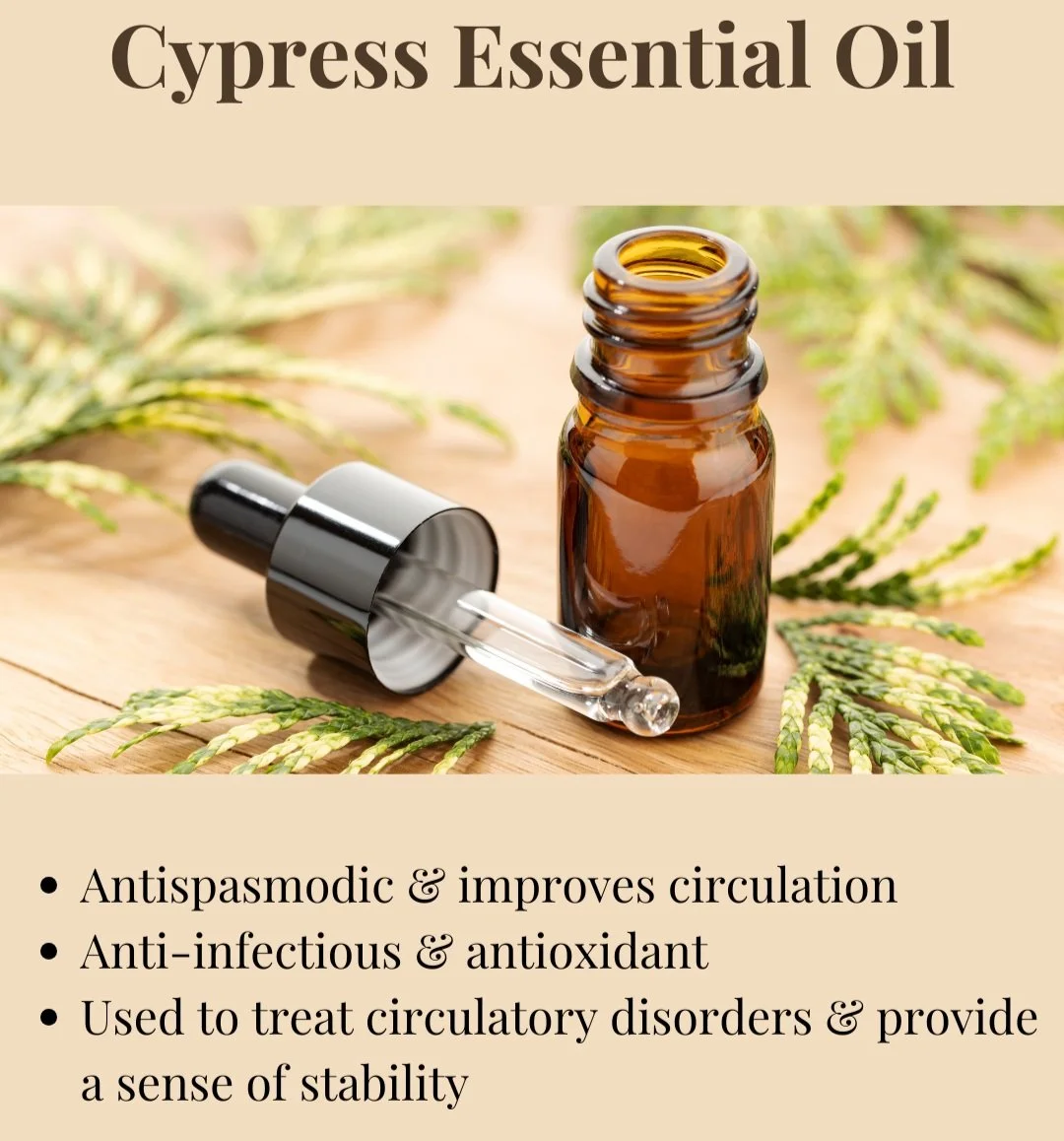Cypress Essential Oil
Welcome to the fourth essential oil in the Raindrop Technique! Cypress essential oil is our focus today. Not just a beautifully diverse coniferous family of trees, but an incredible essential oil that I personally love for its woody scent. Cypress is the fourth essential oil applied to the soles of the feet and to the back in the Raindrop Technique. It is also the first essential oil outside of the Lamiaceae botanical family used.
The Nerdy Stuff
Cypress is part of the Cupressaceae botanical family and has many different varieties. The variety most typically made into an essential oil (and used in the Raindrop Technique) is Cupressus sempervirens, the Mediterranean Cypress. As the name suggests, cypress essential oil is harvested and steam distilled from the twigs and needles of cypress trees grown in the Mediterranean, typically Greece, France, or Spain.
Cypress essential oil infographic.
The key constituents of of cypress oil are:
alpha-Pinene (40-65%)
A monoterpene with a strong woody, piney scent, it is antibacterial, antiviral, antifungal, anti-inflammatory, antioxidative, antitumor, as well as neuro- and gastroprotective. (https://www.sciencedirect.com/science/article/pii/S0031942221002065)
delta-3-Carene (12-26%)
Another monoterpene with a woody scent and lemony taste, this constituent also has anti-inflammatory properties and it can promote a better night sleep, a sense of calm, and even repel insects. (https://visitgreengoods.com/learn/terpene-spotlight-understanding-delta-3-carene/)
beta-Pinene (0.5-3%)
This monoterpene has a minty, piney aroma and is also antibacterial and anti-inflammatory, as well as antidepressant, and cytotoxic (used to kill cancer cells). (https://www.sciencedirect.com/topics/chemistry/beta-pinene)
Myrcene (1-3.5%)
A popular flavoring found most often in hops, Myrcene has powerful analgesic (pain-relieving), antioxidant, and anti-inflammatory properties. (https://pmc.ncbi.nlm.nih.gov/articles/PMC8326332; https://www.sciencedirect.com/topics/agricultural-and-biological-sciences/myrcene)
Limonene (1.8-5%)
Extensively studied, limonene has anti-inflammatory, antioxidant, anticancer, antidiabetic, antiviral, and antinociceptive (inhibits pain detection) properties as well as gastroprotective effects. (https://pubmed.ncbi.nlm.nih.gov/29427589/)
Terpinen-4-ol (1.8-3%)
This monoterpene also has antibacterial, antifungal, and antiviral properties, as well as being cardioprotective, antihypertensive, antioxidant, and anti-inflammatory. (https://www.sciencedirect.com/science/article/abs/pii/S0367326X2400234X)
Actions/Properties
Cypress has been a vital part of Mediterranean culture for millennia, being used to build ships and bows, Egyptian sarcophagi, and Greek statues of gods. It is still used in Tibet as an incense for purification. Historically, cypress cones were used to stop heavy fluid loss such as excess perspiration, diarrhea, or menstruation. The essential oil contains many medical properties that make it yet another powerhouse essential oil:
Improves circulation
Antirheumatic
Antispasmodic
Antioxidant
Diuretic
Vasoconstrictive
Improves respiration
Promotes liver health
Antiseptic
Using Cypress Essential Oil
Cypress essential oil is considered very safe for use aromatically and topically. However, it can be POISONOUS when ingested–so please don’t swallow this essential oil, even if diluted!
In the Raindrop Technique, I apply it to the soles of your feet using the same reflexology technique, a “roll and release” motion, after I apply oregano, thyme, and basil essential oils. On your back, it follows that same order and I apply it and work it into your back using effleurage (light touch) and a finger straddle technique, where I straddle your spine at the base with my index and middle fingers and work my way up your spine to your atlas with a back-and-forth motion.
At home, you can use cypress essential oil topically and aromatically to help relieve hemorrhoids, excessive perspiration (as a deodorant), oily skin, varicose veins, and as an insect repellent. It is also helpful in reducing cellulitis, relieving muscle cramps and edema, and improving circulation. Aromatically, it can help relieve respiratory problems, such as asthma, bronchitis, or spasmodic coughing. Its scent can also act as a tonic to relieve nervous tension and stress.
Additional Sources
Encyclopedia of Essential Oils: The complete guide to the use of aromatic oils in aromatherapy, herbalism, health and well-being. Julia Lawless. Thorson’s Publishing, 2012.
Essential Oils Pocket Reference (6th ed.). Life Science Products and Publishing, 2014.

